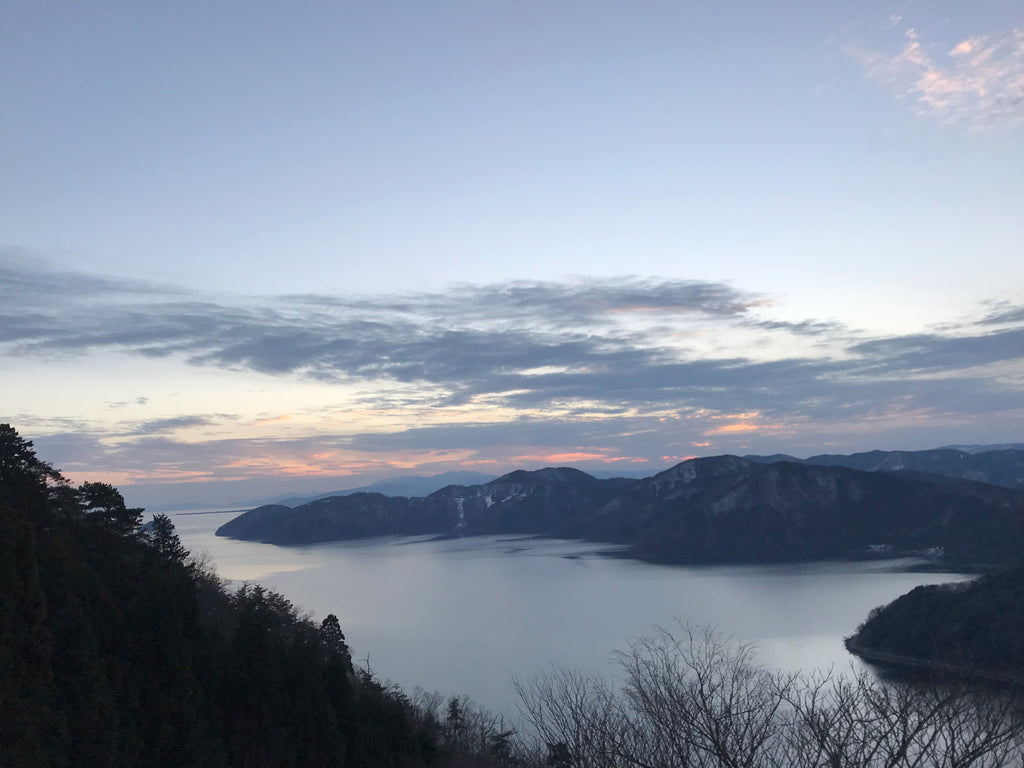 Overlooking Lake Biwa from Mt. Shizugatake
Overlooking Lake Biwa from Mt. Shizugatake
Sake Gumi is our monthly sake subscription service with 150 members throughout California. Join today!
Kayoko and I tend to travel to places in Japan that produce foods and drinks we really like. One of those is sake from Kita Brewery. What prompted our trip to Shiga Prefecture last month was an impromtu invitation from Mayuko Kita of Kita Brewery, asking us to help make koji.
It was very much like us to take the casual invitation from Mayuko-san seriously. Before we knew it, Mayuko-san's dad (owner of Kita Brewery) picked us up at Maibara Station (a bullet train stop between Gifu and Kyoto). Before we arrived to Shiga, I admit that I knew very little about the prefecture – but I was excited to find out what it had to offer in terms of food, history, and sake!

Sakes made in Shiga tend to pair best with their local cuisine. In addition to Shiga's famous Omi beef, local cuisine also includes fermented foods like funazushi (fresh fish pickled in salt to draw out moisture, then compressed with steamed rice to prevent oxidization and encourage fermentation), and tsukudani (seafood, mostly little fish from Lake Biwa, simmered in soy sauce and mirin). I noticed that many of the Shiga sakes have a robust, riceyness on the front and clean, dry finish, with less fruity and floral qualities, perhaps to complement the rich flavors of beef or fermented foods.
I visited two breweries featured in this month's Sake Gumi selection. Kita Brewery makes the Kirakucho which is offered both in Levels 1 and 2 this month. I also visited Tomita Brewery who makes the Shichi Hon Yari Junmai Namazake Spring Seasonal “Fresh Katana”. Make sure to check out both brewery visit articles, plus another about regional foods of Shiga.
If you ever find yourself in Japan shuttling from Tokyo to Kyoto, I really recommend making a stop in Shiga! It's a respite from the crowds – and I guarantee you'll find something unique.
Yoko
LEVEL 1: Introductory Membership (Two 300ml bottles)
 Kirakucho Chokarakuchi Junmai Ginjo
Kirakucho Chokarakuchi Junmai Ginjo
Kita Brewery (Shiga, Japan)
Seimaibuai: Yamada Nishiki 55%, SMV: +14
The Kirakucho Chokarakuchi (Extra Dry) Junmai Ginjo is Kita Brewery's most popular sake. The concept behind this sake is that they wanted to make a sake that was dry but still has koku (richness). It boasts an impressive +14 for the SMV, meaning that on paper, it’s super dry, yet it doesn’t leave behind a stinging in your throat. In fact, this sake seems to represent the Kita Brewery’s mantra: "Making sakes that have koku and kire (clean ending)." Despite it being a junmai ginjo, it's quite light on the fruity and floral. It has a sturdy porridge-like aroma upon entry, but ends satisfyingly dry. The daughter/father duo who works at the brewery agree that this high acidity sake is great chilled with raw squid, yakiniku, and simmered meats.
 Tsukiakari “Moonlight” Junmai Ginjo
Tsukiakari “Moonlight” Junmai Ginjo
Seko Brewery (Shiga, Japan)
Seimaibuai: Ginfubuki 60%, SMV: +1
Here’s another sake from Shiga that proves that they like their sakes to have a satisfying kire. But wait – this isn’t your typcial fruity ginjo (although I sense a little bit of apple in the nose), it also has some nutmeg and cream notes that make this an easy-to-drink, well-balanced sake. The roundness of this sake is a great example of Shiga’s prized soft and clean water. With a slightly lower alcohol content of around 14%, this sake is ideal chilled as an aperitif alongside starters like pickles, and lightly vinegared salads like sunomono.
LEVEL 2: Premium Membership (Two 720ml bottles)
 Kirakucho Chokarakuchi Junmai Ginjo
Kirakucho Chokarakuchi Junmai Ginjo
Kita Brewery (Shiga, Japan)
Seimaibuai: Yamada Nishiki 55%, SMV: +14
The Kirakucho Chokarakuchi (Extra Dry) Junmai Ginjo is Kita Brewery's most popular sake. The concept behind this sake is that they wanted to make a sake that was dry but still has koku (richness). It boasts an impressive +14 for the SMV, meaning that on paper, it’s super dry, yet it doesn’t leave behind a stinging in your throat. In fact, this sake seems to represent the Kita Brewery’s mantra: "Making sakes that have koku and kire (clean ending)." Despite it being a junmai ginjo, it's quite light on the fruity and floral. It has a sturdy porridge-like aroma upon entry, but ends satisfyingly dry. The daughter/father duo who works at the brewery agree that this high acidity sake is great chilled with raw squid, yakiniku, and simmered meats.
 Shichi Hon Yari Junmai Namazake Spring Seasonal “Fresh Katana”
Shichi Hon Yari Junmai Namazake Spring Seasonal “Fresh Katana”
Tomita Brewery (Shiga, Japan)
Seimaibuai: Tamazakae 60%, SMV: +4.7
This robust, strong nama nama genshu is what you want to grab when having wagyu (or better, yet, Shiga’s Omi beef), or something fermented like funazushi, or the stinkiest French cheese you can find. “Fresh Katana” cuts through the richest meats and declares that winter is over. This unapologetic sake is nama at its best: yeasty, a little bitter (akin to a citrus rind), with a sharp finish. What’s more, this is a special spring release that is completely unpasteurized. Keep this bottle chilled and drink asap with prosciutto! Fresh is best. Bottled 12/25/2018!




Comments (0)
There are no comments for this article. Be the first one to leave a message!